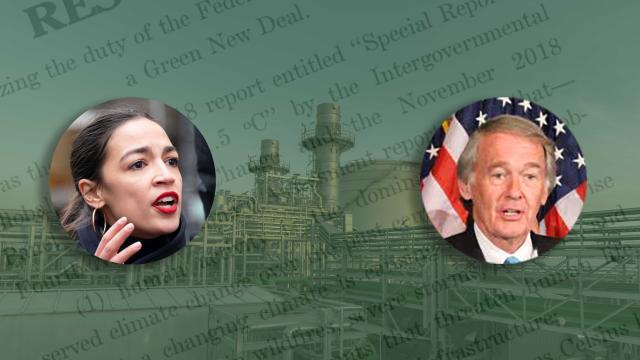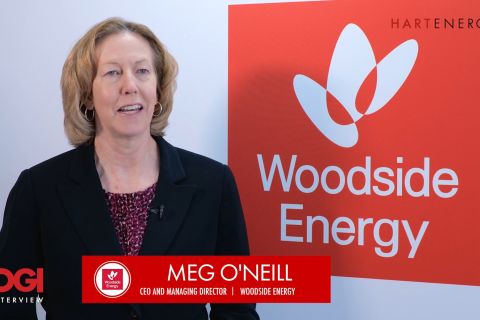
The Green New Deal resolution, proposed by Rep. Alexandria Ocasio-Cortez (D-N.Y.) and Sen. Ed Markey (D-Mass.), could benefit the natural gas sector. (Source: Shutterstock, Sen. Ed Markey’s office, Hart Energy)
Learn more about Hart Energy Conferences
Get our latest conference schedules, updates and insights straight to your inbox.
Since the Green New Deal resolution was introduced early in February by Rep. Alexandria Ocasio-Cortez (D-N.Y.) and Sen. Ed Markey (D-Mass.), it has been lauded as a bold initiative and criticized for lacking in specifics.
While both observations have truth to them, it is important to remember that the Green New Deal is at this point only a proposed resolution, one that few give much chance even of becoming legislation, much less law. That said, is has already succeeded in its essential objective: renewing the national discussion on energy policy and how industry and the economy get from here to there.
For years, natural gas was widely lauded by businesses and many in the environmental community as the bridge fuel between heavy reliance on coal and development of viable and sustainable renewable energy. Ironically, about the same time that gas actually did eclipse coal as the primary power-generation fuel in the U.S., many environmentalists turned against gas.
Now the very vagueness of the Green New Deal’s wish list has many in government, industry and academia looking at specifics. That could bode well for gas being part of a green energy future.
“First of all, we have to get it out of our heads that natural gas, even oil, have no place in the energy future,” said Kenneth B. Medlock III, Baker Fellow in Energy and Resource Economics, and senior director of the Center for Energy Studies at Rice University in Houston. Climate change and the importance of efficient and sustainable energy are a global problem, he stressed.
“In the broader context, the OECD, or industrialized countries, only represent 1.3 billion people out of the 7.7 billion on Earth. There are 3.4 billion people in developing Asia—India, China and the ASEAN countries. Their hunger for energy has already shifted the center of gravity to that part of the world. Beyond that there are still more than 3 billion people in Africa, the Middle East and Latin America.”
All of that means “gas and oil are going to be developed,” said Medlock. “The demographic growth of Asia and the shale revolution in North America means that global energy markets are being refocused to deliver energy to Asia. The scale of energy demand in the rest of the world means that North America is going to be a major gas producer. On an environmental basis that is much better than China and India burning coal.”
In terms of natural gas losing its environmental mojo, Medlock suggested that is not entirely the case. “Some large organizations pivoted against gas, some have not. No one can really say that gas is not part of the energy future.”
He added that some issues, such as leaks of methane, spills from fracking, and widespread flaring, are self-inflicted wounds. “There has always been a cost to energy production, and always will be. But things like flaring of stranded gas have to go away. In the Permian alone there about 500 million cubic feet a day is being flared. That is such a waste, as well as being bad for the environment. That really has to be addressed.”
Medlock is well aware of the logistical and economic challenges of stranded gas, fugitive methane and other environmental issues in natural gas production, but he also knows those issues are solvable with current technology.
The snag is incentive. For example, states are reluctant to ban flaring because they gain jobs and revenue from taxes and fees on industry activity and production. That leaves it to public and political pressure to drive change.
Now, with the Green New Deal staking out one perspective, there is room for other voices.
“The Green New Deal is not realistic and that is very frustrating,” said David Jenkins, president of Conservatives for Responsible Stewardship, based outside Washington. “The proposed resolution combines environmental issues with solving social problems. It hurts to mix those things. There is already bipartisan climate legislation in Congress and that is a heavy enough lift.”
Gas, Jenkins added, “is certainly the bridge fuel. In regions where solar and wind are not economical, gas is going to be the cleanest burning fuel for the foreseeable future. The reason coal is in decline is because gas beats it on price. Even with a price on carbon gas is still a solid investment. Environmentalists should appreciate the ability of gas to displace coal in regions where solar and wind, hydroelectric or geothermal do not have availability or price advantage.”
Recommended Reading
NAPE: Turning Orphan Wells From a Hot Mess Into a Hot Opportunity
2024-02-09 - Certain orphaned wells across the U.S. could be plugged to earn carbon credits.
Exxon Versus Chevron: The Fight for Hess’ 30% Guyana Interest
2024-03-04 - Chevron's plan to buy Hess Corp. and assume a 30% foothold in Guyana has been complicated by Exxon Mobil and CNOOC's claims that they have the right of first refusal for the interest.
Petrobras to Step Up Exploration with $7.5B in Capex, CEO Says
2024-03-26 - Petrobras CEO Jean Paul Prates said the company is considering exploration opportunities from the Equatorial margin of South America to West Africa.
The OGInterview: How do Woodside's Growth Projects Fit into its Portfolio?
2024-04-01 - Woodside Energy CEO Meg O'Neill discusses the company's current growth projects across the globe and the impact they will have on the company's future with Hart Energy's Pietro Pitts.
Deepwater Roundup 2024: Offshore Australasia, Surrounding Areas
2024-04-09 - Projects in Australia and Asia are progressing in part two of Hart Energy's 2024 Deepwater Roundup. Deepwater projects in Vietnam and Australia look to yield high reserves, while a project offshore Malaysia looks to will be developed by an solar panel powered FPSO.






